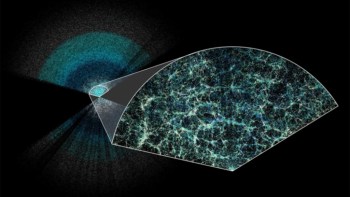Astrophysicists may have found some of the “missing” matter in our local galaxy. Fabrizio Nicastro of the Harvard-Smithsonian Center for Astrophysics and colleagues from Ohio State University and the Observatorio Astronomico di Monteporzio in Italy may have detected the missing matter in gas clouds around the Milky Way. The researchers believe that this pool of ordinary or “baryonic” matter - as opposed to "dark" matter - may be part of the original matter from which our Galaxy and its neighbours formed (F Nicastro et al. 2003 Nature 421 719).
Observations suggest that baryons account for only 4% of the total mass-energy density of the universe, but stars, galaxies, intergalactic clouds and hot X-ray emitting plasma make up for only a third of the expected baryon density. Simulations of galaxy formation predict that a large number of these baryons may have escaped detection because they are very hot and have a low density.
One way of detecting this baryon matter directly is to look for characteristic ultraviolet absorption lines belonging to heavy elements in the spectra of sources such as quasars.
Nicastro and colleagues analyzed the absorption spectra of oxygen ions using the Far Ultraviolet Spectroscopic Explorer (FUSE) satellite and the Chandra and XMM-Newton X-ray observatories. The researchers measured the radial velocities of the oxygen clouds as determined by the Doppler shifts of their absorption lines. In this way they were able to locate the position and origin of these clouds in the galaxy.
The team found that the oxygen absorbers had high radial velocities, greater than 100 kilometres per second. This value is much higher than would be expected for clouds restricted to our galaxy alone. The researchers believe that the oxygen absorbers are spread throughout the entire “Local Group” of galaxies, which includes the Milky Way, Andromeda and about 30 other smaller galaxies and is an area about 5 million light years across.
The extended distribution of this hot gas agrees well with the very low gas densities deduced from x-ray absorption spectra of oxygen ions. The total mass of this ionized gas compares favourably with the mass of the Local Group of galaxies. The researchers estimate that the total mass of baryons in this region is about 1012 solar masses, which is of the order of the mass needed to sustain a stable Local Group. This mass could account for up to 100% of the missing baryons in our Local Group.



